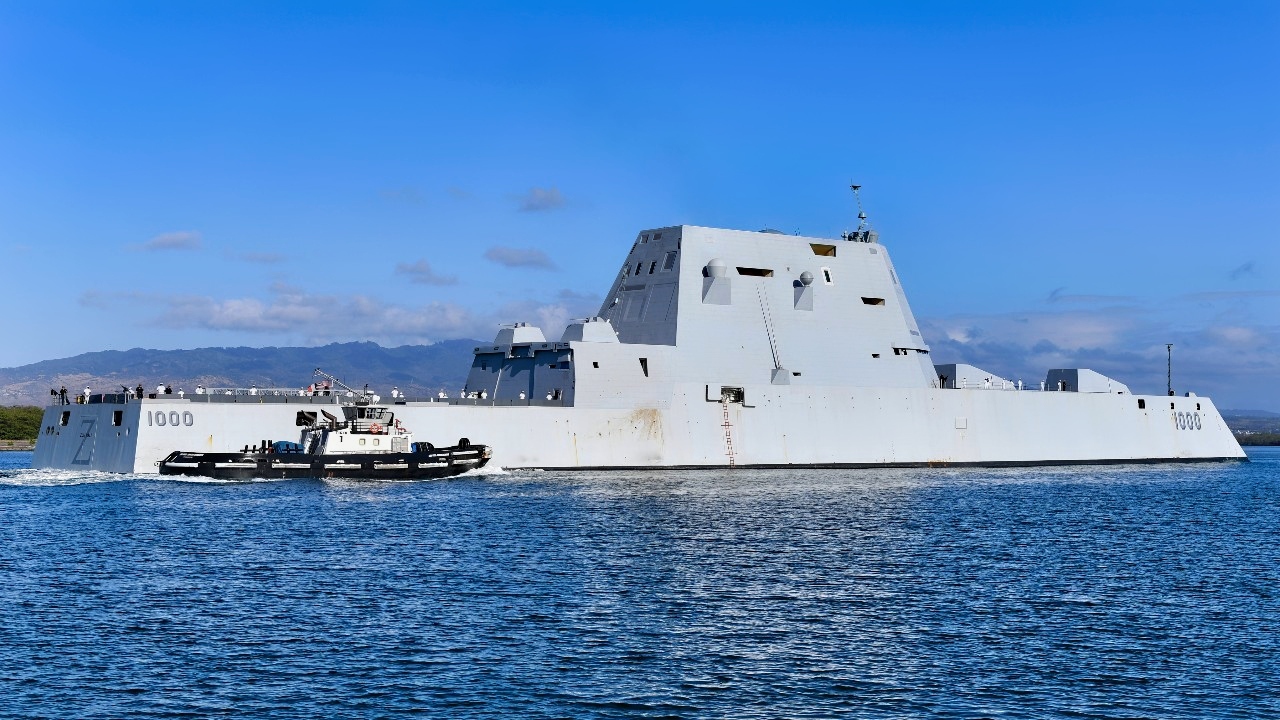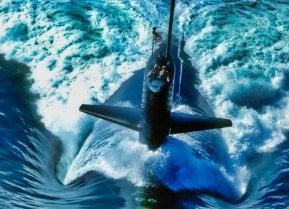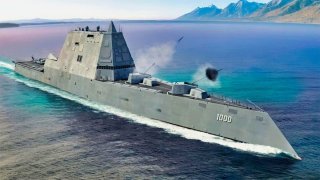$22,000,000,000 Zumwalt-Class Stealth Destroyer Nightmare
The U.S. Navy's Zumwalt-class destroyer, alongside the Littoral Combat Ship (LCS), is considered one of the Navy's most problematic investments. Costing around $22 billion in research and development, the Zumwalt was designed with stealth capabilities and equipped with a 155-mm Advanced Gun System (AGS) for artillery support.
What You Need to Know: The U.S. Navy's Zumwalt-class destroyer, alongside the Littoral Combat Ship (LCS), is considered one of the Navy's most problematic investments. Costing around $22 billion in research and development, the Zumwalt was designed with stealth capabilities and equipped with a 155-mm Advanced Gun System (AGS) for artillery support.

-However, the Navy failed to make the AGS effective, and only three of the initially planned 32 ships were built due to cost overruns and technical issues.
-The specialized ammunition became prohibitively expensive at $800,000 per round. Now, the Navy aims to repurpose these ships to carry hypersonic missiles, but skepticism persists about their viability.
Why the Zumwalt-Class Destroyer Is the Navy's Costliest Mistake
The US Navy’s Zumwalt-class destroyer is, along with the Littoral Combat Ship (LCS), probably the Navy’s worst investment ever.
Costing Navy around $22 billion in research and development, it had stealth features, and was designed to provide artillery support with a 155-mm Advanced Gun System (AGS).
This warship was the reason behind the Chief of Naval Operation in 2006 authorizing the termination of the ammunition supply chains for America’s semi-retired Iowa-class battleships. An addendum inserted by Congress to the National Defense Authorization Act of 1996 instructed the Navy to maintain America’s legendary battleships until the Navy could prove they had a viable, modern replacement for it.
The Navy assumed the Zumwalt was the answer they’d been looking for.
America’s Navy was wrong. The Zumwalt-class ended up being a giant boondoggle that almost everyone hates. The inability of the Zumwalts to perform their intended mission has not only made it a waste of money and resources. This failure to achieve its basic mission has meant that a critical capability gap has formed in the US Navy.
Specifically, the destroyer was meant to provide artillery cover for friendly forces fighting ashore. But things have gotten so bad for the Zumwalt-class that the Navy removed the ship’s 155-mm cannon, effectively castrating the unlucky warship.
Instead, the Pentagon is now looking at making the Zumwalt-class a floating hypersonic missile carrier. Last year, the Navy awarded a $154.8 million contract to Huntington Ingalls Industries (HII) to implement the upgrade. Mind you, the Navy could not get the 155-mm Advanced Gun System (AGS) onboard the Zumwalt-class to work.
The geniuses behind the Zumwalt initially planned for the Navy to order 32 units of these bizarre looking stealth warships. Due to cost overruns and overall inefficiency of the defense industrial base, the Navy ended up with only three.

And this impacts the development of the 155-mm AGS because, as it turned out, the ship’s designers failed to make the new gun system interoperable with the US Army and NATO’s standard 155-mm Howitzer artillery shells. Because there were only three units of the Zumwalt-class as opposed to the original 32 planned, the costs of the artillery pieces that were compatible with the AGS cost a staggering $800,000 per round.
Now the Navy is trying to justify their investment. With the rise in importance of hypersonic weapons, the Navy is clearly to merge the necessary with the utterly unnecessary, in order to justify their sunk cost into the Zumwalt-class destroyer. In fact, the Zumwalt has an assortment of other weaknesses that few other warships have—especially warships that bear the same cost and claim to be as advanced as the Zumwalt-class is.
For example, in 2018, the second Zumwalt-class USS Michael Monsoor (DDG-1001) apparently suffered a blown turbine on its shakedown cruise resulting in it being sent back to the San Diego shipyard, where even more tax dollars will be spent repairing it. These warships are flimsy, their systems are needlessly complex, and these vessels are more of a liability to the United States than they are advantages, whatever stealth capabilities the designers of these boats say they possess.
The entire weapons launch capabilities of the Zumwalt-class will need to be rebuilt to accommodate hypersonic weapons. That’s to say nothing of the fact that the Common Hypersonic Glide Bodies (C-HGB) that the Navy is developing jointly with the US Army are highly experimental. Therefore, the idea that they will be readily available in the next year or so is somewhat laughable.
Even if the C-HGBs are ready on time and work as promised (big ifs), the probability that the easily damaged Zumwalt-class destroyers will be reliable launching platforms in combat. Consider this: the Chinese have arrayed what is probably the world’s most advanced anti-access/area denial (A2/AD) network in the Indo-Pacific.
While the Zumwalt’s designers will likely argue that the stealth features of the Zumwalt would negate whatever advantages China’s A2/AD systems enjoy over other conventional US surface warships, the fact is that these boats are untested.
What’s more, they’re designer for operating dangerously close to enemy shorelines. When one is fighting a terrorist organization or a third world rogue state, there is less of a risk to the Zumwalt from shore (although even this is changing, as the Houthis are showing).
On the face of it, the Navy should be applauded for trying to turn a failure into a success story. The only problem is that the Zumwalt is such a bad system—and it’s old now—that the Navy would be better off either adapting an existing platform, like perhaps a submarine, to launch the C-HGB.
The Navy has wasted billions of three warships that are floating disasters. They’re as embarrassing (or they should be) for America’s national prestige as the Admiral Kuznetsov is for Russia’s.
Turn the Zumwalt-class into scrap. Build the hypersonic weapons. And make them launchable from submarines. Or, better yet, make them compatible for launch with DARPA’s newest unmanned underwater vehicle (UUV), the Manta Ray. That’s the only way that the US Navy will have the firepower and access to burst those Chinese A2/AD bubbles.
About the Author
Brandon J. Weichert, a National Interest national security analyst, is a former Congressional staffer and geopolitical analyst who is a contributor at The Washington Times, the Asia Times, and The-Pipeline. He is the author of Winning Space: How America Remains a Superpower, Biohacked: China’s Race to Control Life, and The Shadow War: Iran’s Quest for Supremacy. His next book, A Disaster of Our Own Making: How the West Lost Ukraine, is due October 22 from Encounter Books. Weichert can be followed via Twitter @WeTheBrandon.
All images are Creative Commons.


